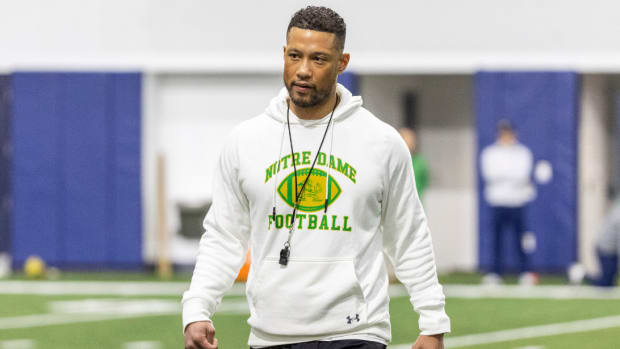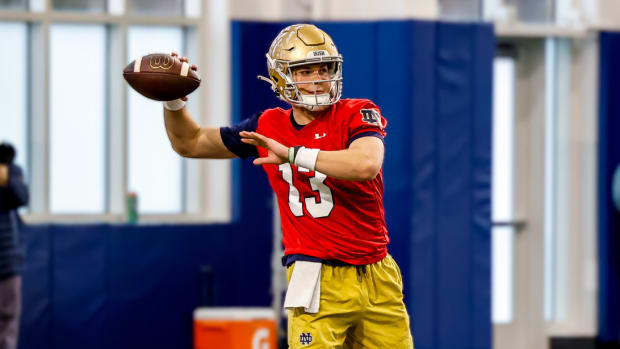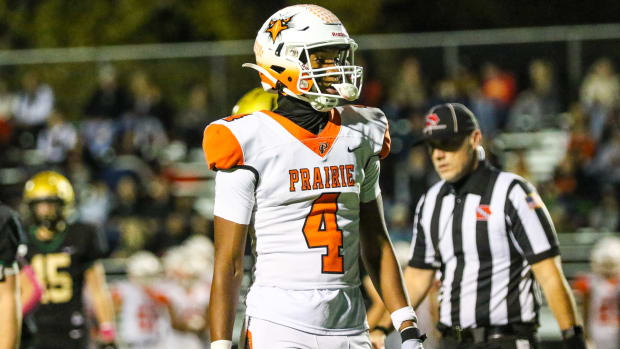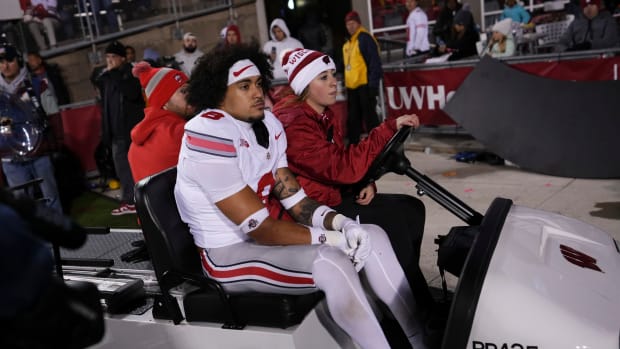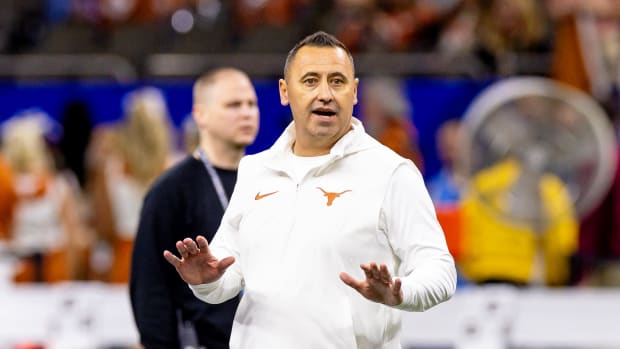Already a Star for Northwestern, Paddy Fisher Is Just Getting Started
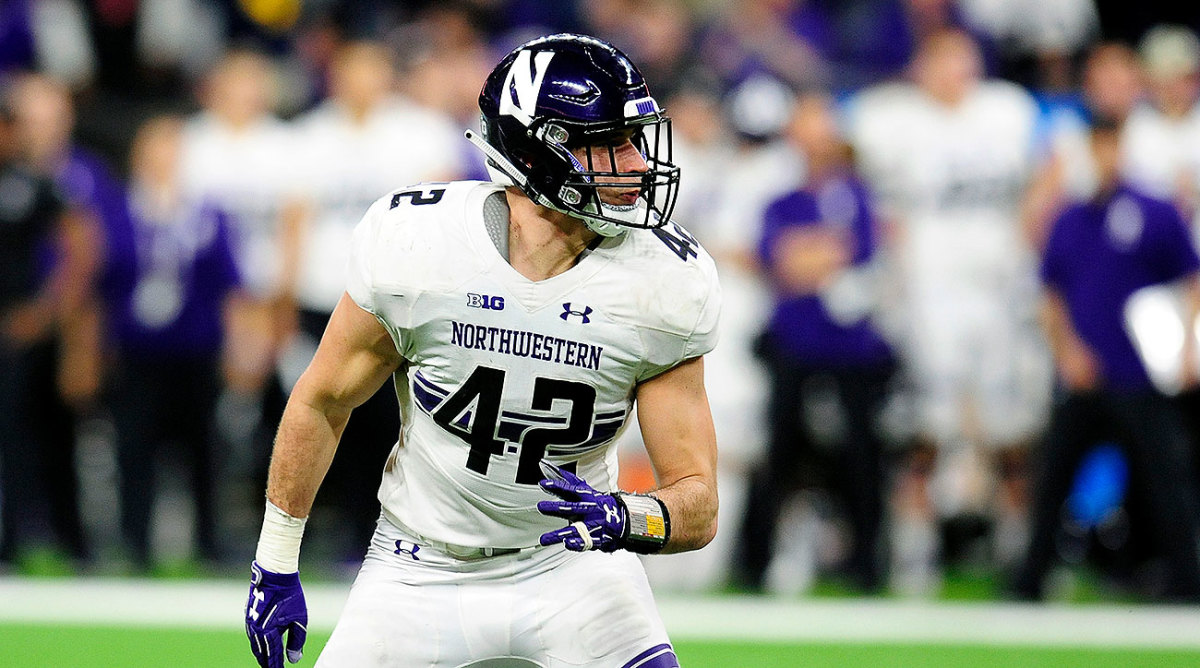
EVANSTON, Ill. — When Paddy Fisher was home in Katy, Texas, over a break last year, he and Travis Whillock, the Northwestern defensive back who attended high school with the linebacker, put on a tape of their youth football highlights. Whillock was suited up at quarterback. Fisher, who now stands 6’4” and weighs 246 pounds, was in at running back. “He was [throwing] touchdown passes,” Fisher says. “I was running around people, which never happens. I don't know when the last time was I ran around someone."
The best linebacker in the Big Ten is veering toward self-deprecating, laughing at the incongruity between that kid, already big for his age and about to be ill-suited to run the ball, and the figure he cuts now: the biggest player at his position on Northwestern’s roster by a margin of two inches and 11 pounds, one of the tallest linebackers in the Big Ten. (Only three players at his position in the conference top 6’4”.) But don’t kid yourself; Fisher can move, to the tune of 227 tackles (14 for a loss), two interceptions, a sack, five passes defensed and eight forced fumbles in just two seasons. As a redshirt junior this fall, he’s the leader of a defense looking to power its team to a second straight Big Ten West title, and as Northwestern continues its best stretch of football in a century, Fisher has a chance to leave his mark on the program in a big way.
Last winter, Fisher would have been eligible to depart for the NFL, but he chose to remain in Evanston through a quarterback transition away from Clayton Thorson, who graduated, to Hunter Johnson, the former five-star recruit who transferred from Clemson. By staying, Fisher has a chance to be a part of program history; should the Wildcats finish this season above .500, it will mark the first time since 1905 that the program will have strung together five winning years.
Pat Fitzgerald’s teams since 2015 have generally made their name on defense, having posted offenses in the bottom half of the FBS in 2015, ’16 and ’18. Over that time, Northwestern has seen six players drafted into the NFL, three of them on defense. Linebacker Anthony Walker in 2017 became the first player of Fitzgerald’s tenure to leave college a year early to turn pro, and he was considered the best defensive player to suit up for Northwestern in decades. By the time Fisher leaves the program, he will have usurped that distinction, and if he does go pro after 2019, he’ll be the second Wildcat, then, to turn pro early. But Fisher has a lot to accomplish between now and that decision, and in the meantime, he plans to show opponents the best combination of size and speed he’s yet displayed at the college level.
When Fisher was a freshman at Katy High School, his coach pulled him up to the varsity team during its state championship run. As a sophomore, he started, which was noteworthy at the powerhouse program. When Fisher was a junior, his team lost in the state title game for the second consecutive year, to the same opponent. Coach Gary Joseph remembers one thing about the postgame ceremony, where Katy’s players were awarded runner-up medals: Fisher refused to take one.
Around that same time, Fisher had begun to get feedback from area camps, where Joseph says coaches told him he wasn’t quick or fast enough to play for them. “I think that soured him on some of the schools around here,” Joseph says, and Fisher began to set his sights outside the state. He kept Baylor and Houston in the mix but looked north and west, at Wisconsin, Washington and Northwestern. In the end, the opportunity to play for a two-time Big Ten Defensive Player of the Year (who also won the Bronko Nagurski Award and Chuck Bednarik Award twice each while playing linebacker at Northwestern) won out. “It’s incredible,” Fisher said on the Big Ten Network this month about playing for Fitzgerald. “He’s always dropping little dimes of knowledge here and there. He’s sitting in on position meetings during camp. He’s in every room, really, but he spends a lot of time with the linebackers.”
After redshirting in 2016, Fisher made an immediate impact in 2017, when Northwestern finished 10–3 and won the Music City Bowl. For a player who says he didn’t even realize he was good at football until he was in high school, Fisher was able to make mincemeat of opposing skill players from the start, displaying the same relentless approach that had elevated him to varsity so quickly in Katy. Blessed with long arms and remarkable instincts both before and after the snap, Fisher uses his wingspan and size to his advantage. He can get off blockers and attack linemen better than most, and he’s learned to use his frame as leverage. He’s working to improve his pass-coverage skills, too, leaning on the fundamentals and film-watching that have always provided the backbone to his approach. In the film room solo, Fisher says, he tries to pick up on keys that the position group might not discuss, looking at the alignment of a running back or a receiver, offensive linemen demeanor, what he calls the “little nuances that I can pick up in my off time.”
"He takes everything and runs with it,” Whillock, who grew up a three-minute walk from Fisher and has been close friends with the linebacker since nursery school, says. “There's no laying back, (nothing) lackadaisical. It's all in, every single day.
"I think he's always been an instinctual player, which is why he's able to be around the ball all the time,” Whillock adds. “I think turnovers are something that he works on every single day, and I think it's shown in these past few years. I think being able to run sideline-to-sideline, that speed, I think he's definitely worked on that. Our staff here, the strength staff, has done a great job working with him on that lateral quickness and being able to get in and out on breaks."
Fisher still jokes about that speed—or the perceived lack of it that might have discouraged him but instead lit him on fire. This offseason, he’s put a special focus on quickness, starting with intense conditioning sessions in January. “[Speed is] something that some people are born with and some people aren't,” Fisher says, “but it's also something that you can work at. You know, will I ever run a 4.4 [second 40-yard dash]? No. But I can work at something and get better at it. I firmly believe that I can improve in every aspect and area of my life. I've gotten a lot of improvement in terms of strengthening my legs.” From there, the linebacker begins to rattle off a litany of muscle groups: gluteus maximus, hamstrings, quadriceps, gluteus medius, quadratus lumborum. It’s a veritable anatomy lesson, and also a warning to the rest of the Big Ten: If you weren’t already terrified of Paddy Fisher, now’s the time to be.
In the summer of 2018, Fisher moved in with Whillock and Brian Bullock, another defensive back and Texas native. At their apartment, which Whillock found, Fisher has spent much of the past year quietly irking his best friend by using his bathroom instead of the one he is supposed to share with Bullock. After so many years of closeness, the two players know exactly how to irk each other, know what the other is thinking, and even, Whillock claims, notice things about the other that he can’t see in himself. Lately, Whillock has begun to wonder: Is Fisher still growing?
From three inches shorter, the defensive back swears the gap is widening between himself and his roommate. When he’s told Fisher about this suspicions, the linebacker has been emphatic: “I hope not.” Still, Whillock maintains there’s been at least some height gain since both arrived in Evanston in 2016, the linebacker’s literal stature swelling with his prominence at Northwestern. Fisher remains unconvinced, though he did notice one anatomical quirk recently: At a shoe store, he measured his size-13 feet only to find they came out as size 12.5.
Maybe it was a bad tool. Or it could be all that cardio. Trimmer feet? Maybe. Regardless, Fisher has chiseled his frame from top to bottom, to a point light-years away from the running back on those tapes and just as far from the high-schooler who was told he might be too slow. Even so, Whillock says, his friend sees more elements of his game in which he can improve, even at the techniques and fundamentals he already does so well. “That's even scarier,” Whillock says, “because I know he can be that much better."


